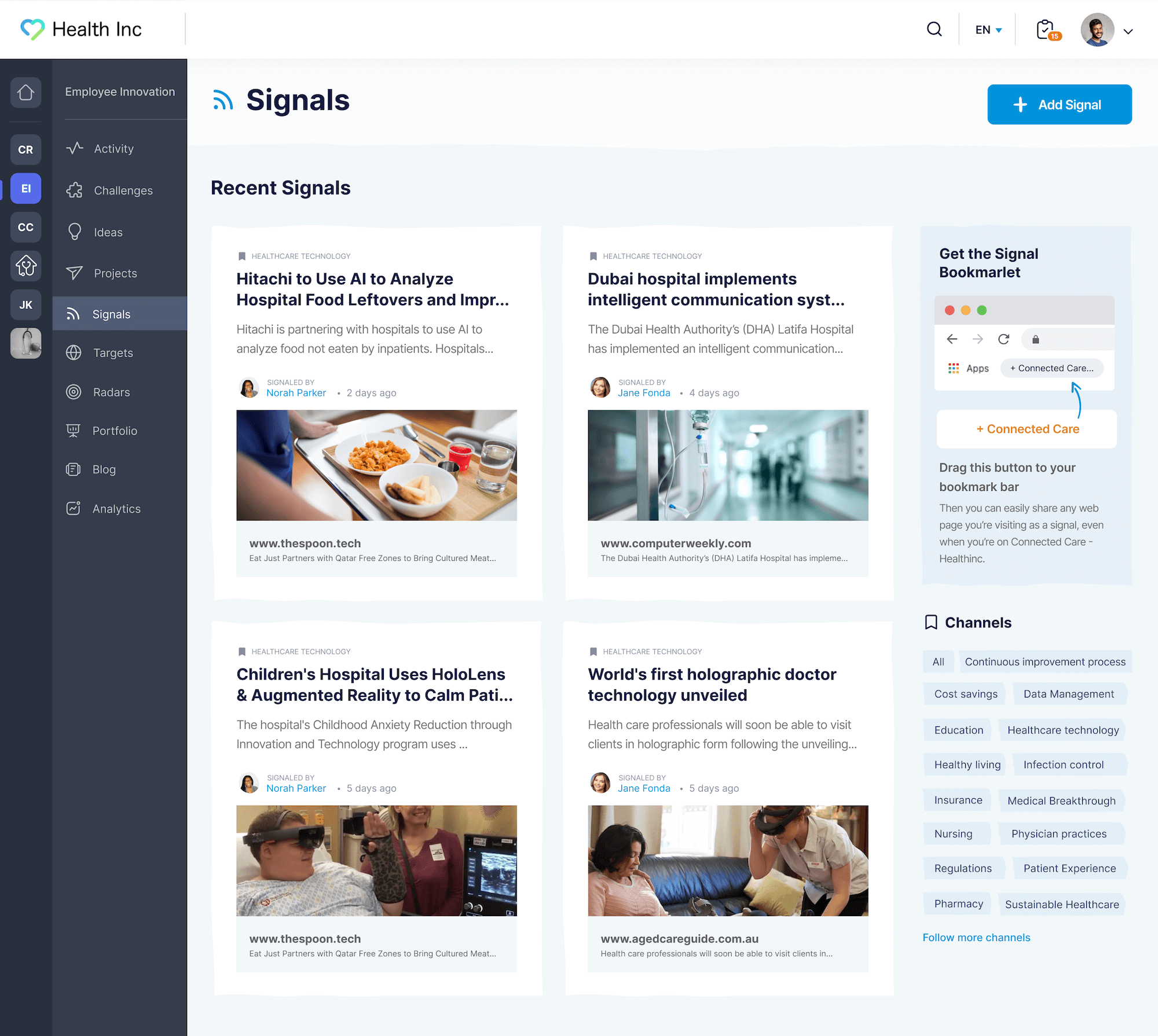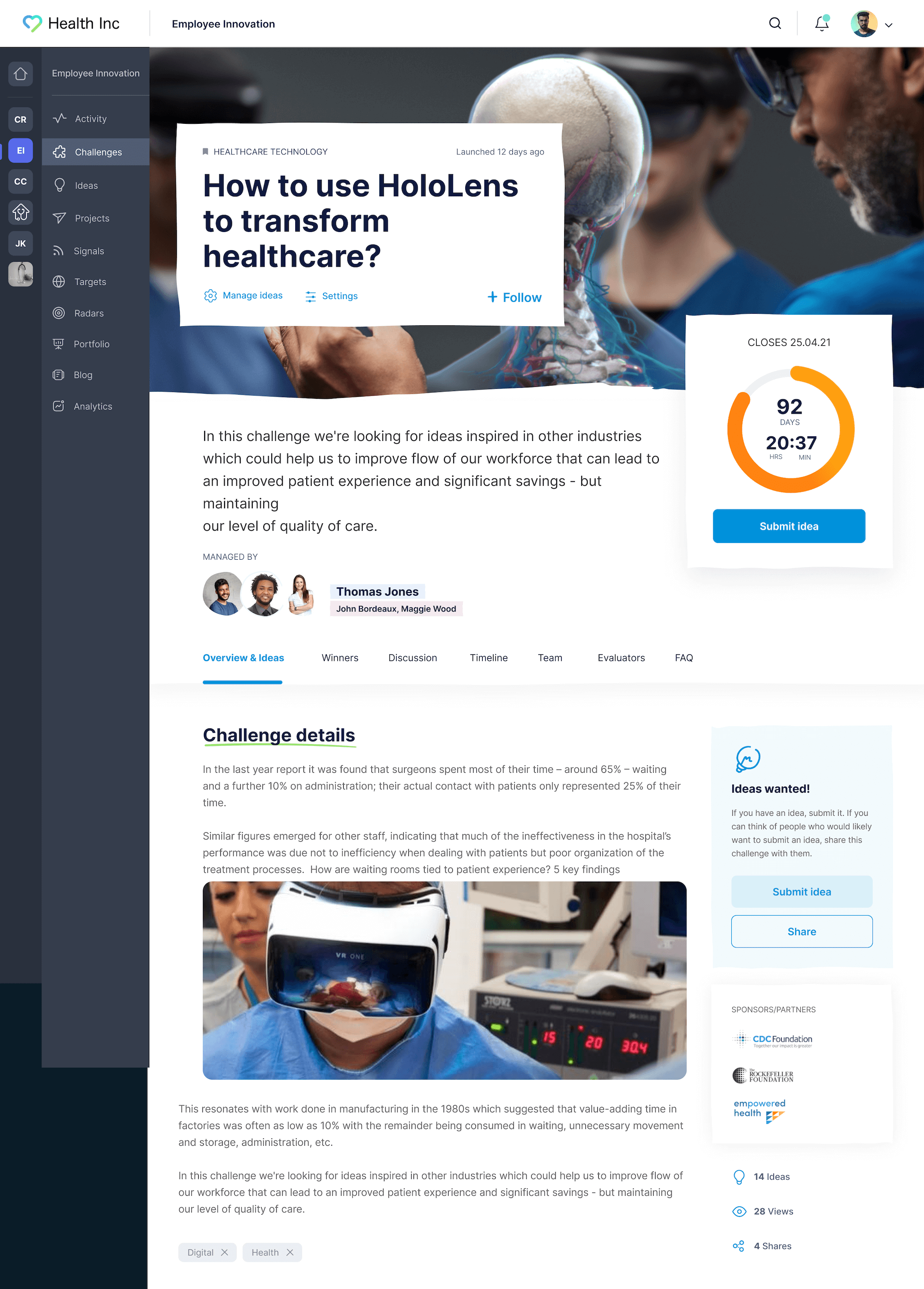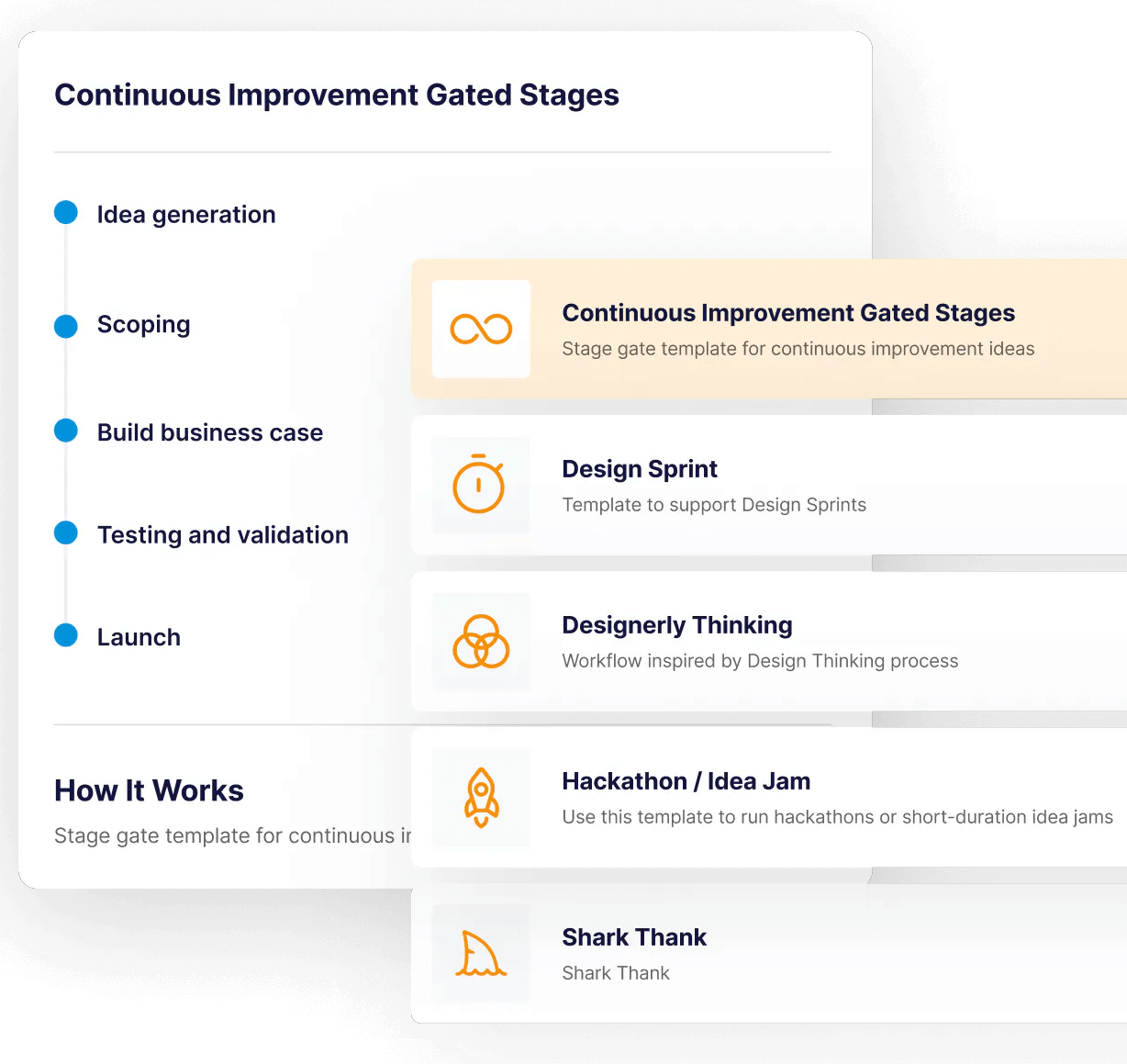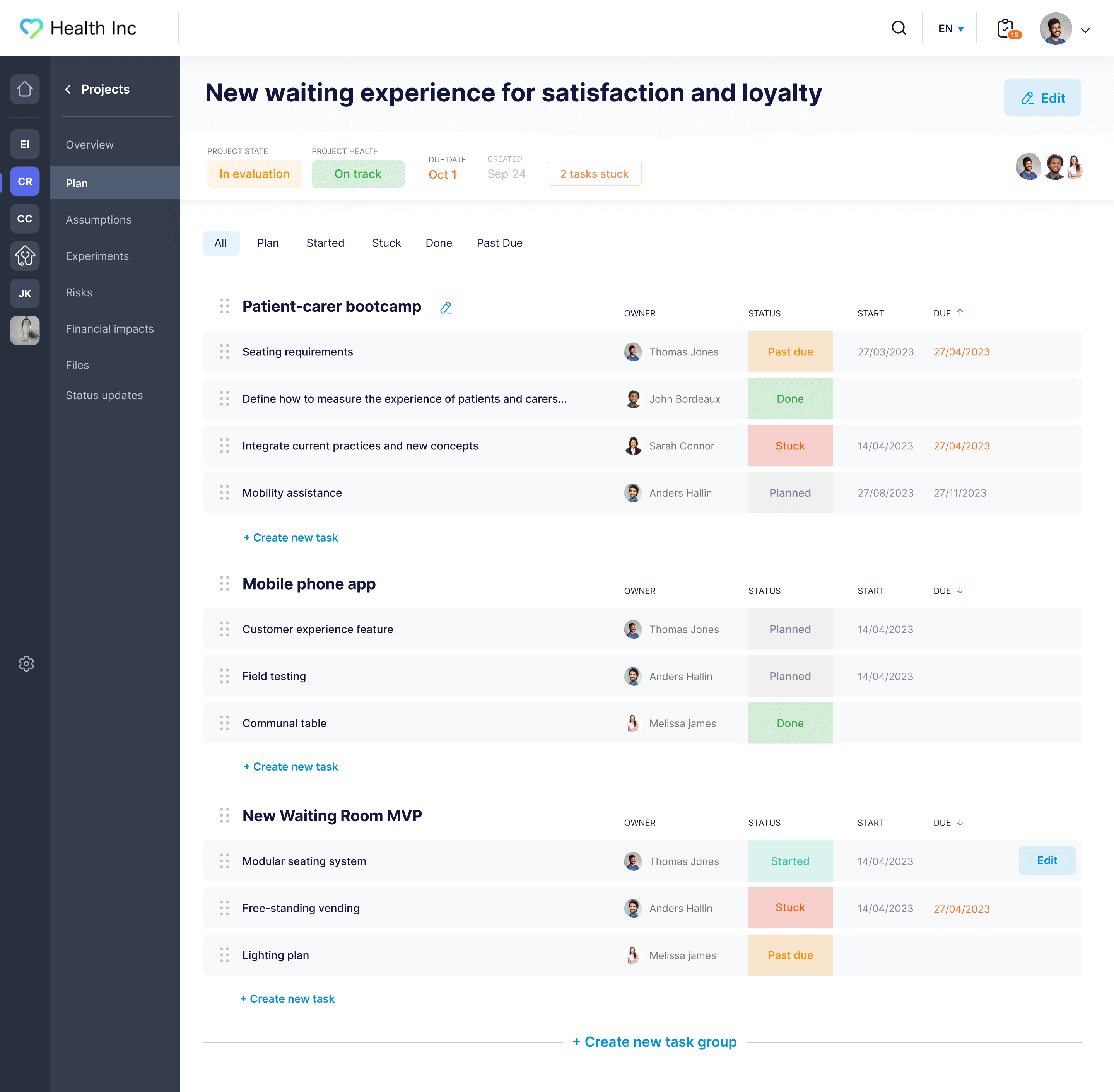ISO 56002 is an international standard that provides guidance on establishing, implementing, and maintaining a productive innovation management system (IMS). It was developed and published by the International Organization for Standardization (ISO), drawing on the expertise of innovation experts worldwide — including our team at InnovationCast.
Setting up an ISO-aligned innovation management system enables organizations to:
Generate value from ideas: ISO 56002 outlines steps to managing innovation from ideation to implementation. This is fundamental since most organizations don’t have systems to turn ideas into solutions, so they fail to realize their value.
Adapt to emerging opportunities: ISO 56002 recommends keeping a pulse on new opportunities and exploring ways of addressing them. This helps organizations improve competitiveness and profitability while quickly responding to disruptive technologies.
Minimize wasted resources: ISO 56002 provides clear resource allocation and validation frameworks, helping organizations reduce risk and uncertainty before investing resources into development.
ISO 56002 contains seven main clauses discussing distinct facets of launching an effective innovation management system:
Context of the organization explores identifying growth opportunities. This could be unmet customer needs, flaws in the current offering, or process inefficiencies.
Leadership stresses the importance of top management taking responsibility for the innovation management system.
Planning reviews how organizations should plan to address growth opportunities.
Support talks about how top management should provide resources such as time, knowledge, budget, IP management, and infrastructure to support innovation efforts.
Operations cover five steps required to generate high-quality innovation ideas and develop them into solutions (i.e., identify opportunities, develop concepts, validate, develop, and deploy).
Performance evaluation discusses how to conduct internal audits of the innovation management system and identify improvement areas.
Improvement covers how organizations can make continual improvements to the innovation management system.
To learn more about all seven clauses, you can purchase the ISO 56002 document here.
In this article, we’ll focus on the leadership and operations clause, which provides the foundation for establishing an innovation management system that delivers impactful solutions.
But first, here’s a brief overview of how ISO 56002 fits into the wider ISO 56000 landscape.
How Does ISO 56002 Fit Into the ISO 56000 Series?
ISO 56002 is part of the ISO 56000 family of standards. Each standard addresses a specific aspect of innovation management. Together, they provide a comprehensive blueprint to help organizations manage innovation.
ISO 56000:2020: Fundamentals and Vocabulary: Establishes fundamental innovation terms that help prevent miscommunication.
ISO 56001: Innovation Management System — Requirements: Details mandatory requirements for establishing innovation management systems.
ISO 56002:2019 Innovation Management System — Guidance: Explores best practices for implementing innovation management within organizations.
ISO 56003:2019 Tools and Methods for Innovative Partnerships: Covers how organizations can connect with outside innovators.
ISO 56004:2019 Innovation Management Assessment: Examines self-assessment best practices that organizations can use to audit their innovation management system.
ISO 56005:2020 Tools and Methods for Intellectual Property Management: Shows organizations how to manage and protect intellectual property.
ISO 56006: Tools and Methods for Strategic Intelligence Management: Guides organizations on managing strategic intelligence, i.e., scanning the external world and using that information to innovate.
ISO 56007: Tools and Methods for Idea Management: Discusses the corporate tools needed to manage innovation.
ISO 56008: Tools and Methods for Innovation Operation Measurements: Covers how organizations can measure innovation.
Leadership Clause: The Importance of Leadership Commitment and Support
Leadership support is the foundation of a productive innovation management system — departments need budget, time, and infrastructure from top management and stakeholders to support their innovations. Without this support, it’s very difficult to implement the innovation management principles we’re going to discuss below.
The ISO 56002 document says that top management must:
Be accountable for the innovation management system.
Ensure the adoption of the innovation management system across the entire organization.
Support leaders across all levels and departments.
Distribute budgets so departments can pursue ideas.
Assign responsibilities so everyone knows what’s required of them.
Ensure the innovation management system is at the service of the organization’s objectives.
With this leadership commitment, employees and other innovation participants understand the importance of contributing to innovation. They know that if they identify promising opportunities and develop high-quality concepts, leadership will allocate the necessary resources for validation and potential implementation.
Additionally, employees know that leadership understands failure is part of innovation — if their concepts don’t live up to expectations, it won’t negatively affect their future career opportunities.
This leadership commitment and support ultimately fosters a culture of innovation where the entire workforce is continuously browsing for opportunities and testing new concepts.
Operations Clause: How to Establish an Organization-Wide Innovation Management System
From our perspective, the operations clause is a core of the ISO 56002 document because it translates an organization's innovation strategy and objectives into actionable processes.
This section covers the five steps ISO 56002 puts forth for instituting an innovation management system.
Identify opportunities
Create concepts
Validate concepts
Develop concepts
Deploy concepts
In addition, because organizations with the best ISO-compliant innovation systems use dedicated innovation management software (not ad hoc tools like spreadsheets and surveys), we review how InnovationCast helps organizations meet each ISO standard.
If you’d like to learn more about how InnovationCast helps establish ISO 56002-compliant innovation systems, schedule a quick demo.
1. Identify Opportunities
The core message that ISO 56002 conveys is that innovation must serve the organization’s goals.
Therefore, ISO advises first pinpointing opportunities for growth. This could be improving product offerings, expanding into new markets, or optimizing internal processes to boost efficiency.
Organizations commonly identify opportunities by asking innovation participants to surface insights such as emerging startups, competitor news, industry trends, customer feedback, and new technologies. Top management reviews these insights and decides what’s worth focusing on.
As per the ISO, the opportunities should be aligned with the organization’s intent and supported by the innovation strategy. An innovation strategy describes what the organization wants to accomplish with innovation.
By creating and communicating an innovation strategy, participants in the innovation activities are clear on what opportunities are a priority and can focus their creative energy on them.
For instance, the organization’s innovation strategy may entail:
Customers are highlighting a specific usability problem with our product. We need to fix it.
Certain emerging technologies may be a threat to our business in the future. We need ways to address it.
Our main competitor just launched a new product for a new market segment. We want to win in the same market.
However, ISO 56002 recognizes that domains constantly change, so the innovation strategy must remain flexible as employees learn about new opportunities.
This creates a two-way street of sorts where employees primarily focus on addressing opportunities in the innovation strategy, but when they encounter something new, they can bring it to the attention of top management and potentially change the strategy.
How InnovationCast Helps Identify Opportunities
To help organizations identify and stay updated on opportunities, we designed InnovationCast with a trend management feature called Signals & Scouting.
Organizations can invite employees to InnovationCast to share resources like news stories, press releases, competitor news, research studies, and customer feedback. InnovationCast centralizes these resources in the activity feed.

When employees log in, they can discuss these resources with colleagues and top management to determine if they should be added to the innovation strategy. From there, everyone can collaborate to develop potential solutions.
This allows organizations to leverage the brainpower and experiences of the entire workforce to identify opportunities.
Read more: How to Create a Collaborative Innovation Process and Network
2. Create Concepts That Address Opportunities
Once the organization has developed an innovation strategy based on their strategic direction, it must communicate it to employees and all innovation participants.
Innovation participants should review the opportunities inside the strategy and craft concepts that can capitalize on them.
ISO 56002 requires each concept to contain:
Preliminary value realizations. These are statements detailing why the organization should implement the concept.
Assumptions or hypotheses for the concept to be validated. This breaks down what conditions must be valid for the concept to be successful.
Information around potential risks, novelty, and resource requirements. This ensures evaluators have all the information needed to evaluate concepts.
This ISO requirement addresses two common organizational mistakes: (1) failing to communicate the innovation strategy to all participants, and (2) not filtering out low-quality, incomplete concepts.
Instead, most organizations take a digital suggestion box approach, creating a Slack channel or web page where employees can submit any concept, regardless of its relevance to the innovation strategy. Once submitted, only a few evaluators have access.
This has three ramifications on the innovation management system:
Concepts aren’t relevant to opportunities in the innovation strategy: Employees, unaware of the organization’s focus, submit any concept. As a result, most ideas are discarded, which can lower morale and engagement.
Concepts aren’t high-quality: Without visibility into colleagues’ submissions and the ability to collaborate, organizations collect primarily unrefined, low-quality concepts.
Participation is slow: With the suggestion box always open, there’s little urgency for employees to submit concepts.
To address this, we added Innovation Challenges to InnovationCast.
How InnovationCast Supports Concept Creation
Innovation Challenges are time-sensitive calls for concepts relevant to opportunities in the innovation strategy.
Organizations can create a separate challenge around each opportunity in the innovation strategy, and InnovationCast calls everyone to contribute.

Innovation Challenges offer three advantages over the digital suggestion box:
Concepts are relevant to opportunities in the innovation strategy: Employees can view opportunities and submit only relevant concepts.
Concepts are high-quality and non-generic: When someone shares a concept, others can view it, contribute their expertise to improve it, and challenge the author’s value proposition. This leads to more thoughtful, complete concepts.
Employees are more engaged: All challenges have deadlines, requiring employees to participate quickly.
Read more: How to Implement an Effective Idea Generation Process in Your Organization
3. Validate Concepts
ISO 56002 emphasizes the need for validation before proceeding with a full-scale launch.
Validation involves defining assumptions or hypotheses about the prerequisites for success and running experiments to test them.
It’s necessary because it enables organizations to test customer demand, feasibility, and impact with minimal resources.
ISO 56002 advises testing the highest-risk and highest-uncertainty assumptions first, so organizations can quickly determine whether the project is worth pursuing or should be abandoned.
As organizations validate assumptions, they should adapt and refine the concept to reflect their learnings.
Validation continues until:
The most important assumptions — those that can make or break the project — are validated, and the concept is ready to be implemented.
Teams invalidate one or more assumptions that they cannot pivot around and must abandon the concept.
The outputs of validation are concepts with a low enough level of risk and uncertainty that warrants full development.
Note: Validation is necessary for new product development due to the high level of risk and uncertainty involved. However, it typically isn’t necessary for continuous improvement, as these involve small changes to existing offerings that are supported by substantial data. The level of certainty is high, and if the idea fails, the consequences are minimal.
How InnovationCast Supports Concept Validation
As we mentioned in our founding story, most organizations overemphasize concept creation, often treating it as the entire innovation management process. They overlook subsequent steps like validation, which prevents concepts from reaching their full potential as shippable solutions.
To assist with validation, we’ve incorporated detailed workflows into InnovationCast.
These workflows guide organizations through the necessary steps after concept creation, which typically include:
Hypotheses or assumptions to define (e.g., customer demand, technical feasibility, time-to-market)
Experiments to validate those assumptions (e.g., run ads to a landing page and track checkout rates, build a business case, run a financial risk analysis)
Competencies to involve (e.g., marketers, engineers, designers)
KPIs to measure and determine whether an assumption is valid (e.g., checkouts, conversion rates, click-through rates).

In addition, InnovationCast provides workflows tailored to various types of innovations, such as revolutionary ideas, startup scouting, new product concepts, continuous improvements, business models, and more. Unlike most innovation software, you’re not limited to just one workflow.
As concepts progress through the workflow, InnovationCast sends email alerts to the person responsible for the next task, ensuring that contributions are made on time and keeping validation projects on track.
4. Develop Concepts
After validation, organizations are left with concepts that carry acceptable levels of risk and uncertainty, justifying the development of the complete solution. During development, the ISO 56002 standard requires organizations to:
Call the project management office (or whoever’s responsible for launching new products) to build a working solution.
Assess their internal competencies and determine whether they can do everything in-house or need to partner with other organizations.
Continue the validation process by assessing potential risks that may arise during deployment. These risks are often related to data privacy regulations, production scalability, user acceptance, and development time.
Conduct a state-of-the-art search to check whether the new solution infringes on copyrighted material.
These efforts result in fully realized products, services, or processes that deliver value to the organization.
We’d like to emphasize that while the validation stage helps reduce risk and uncertainty, it’s impossible to eliminate it entirely.
We sometimes see that teams validate all assumptions and firmly believe in a concept’s success, yet when the full product launches, it sometimes fails to meet expectations.
To mitigate this, organizations should define key metrics to track during development and ensure shared awareness of these metrics among the innovation department, top management, and the project management office.
As organizations learn more about the solution, they should continue iterating — much like ongoing validation during development. Very few solutions remain unchanged from initial design through deployment.
How InnovationCast Supports Concept Development
InnovationCast has a project management feature that organizations can use to plan the development of an innovation.

Project leaders can create tasks, assign them to a team or employee, establish deadlines for when it is due, and set up automated notifications that ping users when their expertise is needed.
5. Deploy Concepts
The final stage of the operations clause is concept deployment, where organizations consider developed concepts as inputs and make them available to interested parties such as customers, partners, and employees.
Here are some best practices from the ISO 56002 document:
Collaborate with marketing teams to create promotional materials and raise awareness of the innovation.
Work with suppliers to develop scalability plans and ensure the organization can meet demand.
Gather customer feedback to improve the innovation and implement those improvements.
Monitor the impact of the innovation on the organization, tracking adoption rates and sales figures as recommended by ISO.
The first three points are self-explanatory, as they involve typical project management best practices. However, we want to highlight the importance of measuring the impact of innovations.
In our experience, organizations often make two mistakes when measuring innovation:
Focusing solely on vanity metrics like participation rates, without measuring financial performance. This leaves top management unaware of the return innovation is generating, making it harder to secure funding for future innovation.
Failing to track the long-term performance of innovations. This leads to the misconception that a solution is successful, but when the initial hype fades, it may fall short on key benchmarks.
To learn more about our systems approach to measuring innovation, read this guide.
How InnovationCast Supports the Tracking of Innovations
InnovationCast has a portfolio management feature and reporting dashboard that enables organizations to see all innovation initiatives, allocated budgets, and the results they generate.
Organizations can track KPIs, such as:
Sales revenue
Customer acquisition rate
Market share growth
Customer satisfaction and feedback scores
Product usage
And more
We set up this reporting dashboard during onboarding by pulling data from your organization's data visualization tools. InnovationCast integrates with Google Charts, Microsoft Power BI, Tableau, and more.
Implement an ISO 56002 Innovation Management System with InnovationCast
Schedule a demo with our customer support team to learn more about how InnovationCast supports these best practices.
Related reads:

